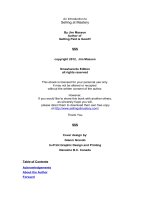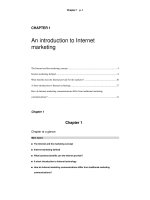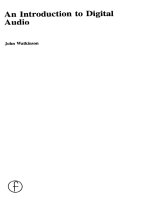an introduction to options trading - de weert 2006
Bạn đang xem bản rút gọn của tài liệu. Xem và tải ngay bản đầy đủ của tài liệu tại đây (1.13 MB, 178 trang )
AN
INTRODUCTION
TO OPTIONS
TRADING
Frans de Weert
AN INTRODUCTION TO
OPTIONS TRADING
The Securities & Investment Institute
Mission Statement:
To set standards of professional excellence and
integrity for the investment and securities industry,
providing qualifications and promoting the highest
level of competence to our members, other individuals
and firms.
The Securities and Investment Institute is the UK’s leading
professional and membership body for practitioners in the
securities and investment industry, with more than 16,000
members with an increasing number working outside the
UK. It is also the major examining body for the industry,
with a full range of qualifications aimed at people entering
and working in it. More than 30,000 examinations are taken
annually in more than 30 countries.
You can contact us through our website www.sii.org.uk
Our membership believes that keeping up to date is central to
professional development. We are delighted to endorse the
Wiley/SII publishing partnership and recommend this series
of books to our members and all those who work in the
industry.
As part of the SII CPD Scheme, reading relevant financial
publications earns members of the Securities & Investment
Institute the appropriate number of CPD hours under the Self-
Directed learning category. For further information, please
visit www.sii.org.uk/cpdscheme
Ruth Martin
Managing Director
AN
INTRODUCTION
TO OPTIONS
TRADING
Frans de Weert
Copyright # 2006 John Wiley & Sons Ltd, The Atrium, Southern Gate, Chichester,
West Sussex PO19 8SQ, England
Telephone (þ44) 1243 779777
Email (for orders and customer service enquiries):
Visit our Home Page on www.wiley.com
All Rights Reserved. No part of this publication may be reproduced, stored in a retrieval
system or transmitted in any form or by any means, electronic, mechanical, photocopying,
recording, scanning or otherwise, except under the terms of the Copyright, Designs and
Patents Act 1988 or under the terms of a licence issued by the Copyright Licensing Agency
Ltd, 90 Tottenham Court Road, London W1T 4LP, UK, without the permission in writing of
the Publisher. Requests to the Publisher should be addressed to the Permissions Department,
John Wiley & Sons Ltd, The Atrium, Southern Gate, Chichester, West Sussex PO19 8SQ,
England, or emailed to , or faxed to (þ44) 1243 770620
Designations used by companies to distinguish their products are often claimed as trademarks.
All brand names and product names used in this book are trade names, trademarks or registered
trademarks of their respective owners. The Publisher is not associated with any product or
vendor mentioned in this book.
This publication is designed to provide accurate and authoritative information in regard to
the subject matter covered. It is sold on the understanding that the Publisher is not engaged
in rendering professional services. If professional advice or other expert assistance is
required, the services of a competent professional should be sought.
Other Wiley Editorial Offices
John Wiley & Sons, Inc., 111 River Street, Hoboken, NJ 07030, USA
Jossey-Bass, 989 Market Street, San Francisco, CA 94103-1741, USA
Wiley-VCH Verlag GmbH, Boschstr. 12, D-69469 Weinheim, Germany
John Wiley & Sons Australia Ltd, 42 McDougall Street, Milton, Queensland 4064, Australia
John Wiley & Sons (Asia) Pte Ltd, 2 Clementi Loop #02-01, Jin Xing Distripark, Singapore 129809
John Wiley & Sons Canada Ltd, 6045 Freemont Blvd, Mississauga, Ontario, Canada L5R 4J3
Wiley also publishes its books in a variety of electronic formats. Some content that appears
in print may not be available in electronic books.
British Library Cataloguing in Publication Data
A catalogue record for this book is available from the British Library
ISBN-13 978-0-470-02970-1 (PB)
ISBN-10 0-470-02970-6 (PB)
Project management by Originator, Gt Yarmouth, Norfolk (typeset in 12/16pt Trump Mediaeval).
Printed and bound in Great Britain by T.J. International Ltd, Padstow, Cornwall.
This book is printed on acid-free paper responsibly manufactured from sustainable forestry
in which at least two trees are planted for each one used for paper production.
To Jan and Annelies
CONTENTS
Preface xiii
Acknowledgements xv
Introduction xvii
1 OPTIONS 1
1.1 Examples 3
1.2 American versus European options 7
1.3 Terminology 8
1.4 Early exercise of American options 13
1.5 Payoffs 15
1.6 Put–call parity 16
2 THE BLACK–SCHOLES FORMULA 21
2.1 Volatility and the Black–Scholes formula 28
2.2 Interest rate and the Black–Scholes formula 29
2.3 Pricing American options 31
3 DIVIDENDS AND THEIR EFFECT ON
OPTIONS 33
3.1 Forwards 34
3.2 Pricing of stock options including
dividends 35
3.3 Pricing options in terms of the forward 36
3.4 Dividend risk for options 38
3.5 Synthetics 39
4 IMPLIED VOLATILITY 41
4.1 Example 44
4.2 Strategy and implied volatility 45
5 DELTA 47
5.1 Delta-hedging 52
5.2 The most dividend-sensitive options 57
5.3 Exercise-ready American calls on dividend
paying stocks 57
6 THREE OTHER GREEKS 61
6.1 Gamma 62
6.2 Theta 65
6.3 Vega 69
viii CONTENTS
7 THE PROFIT OF OPTION TRADERS 73
7.1 Dynamic hedging of a long call option 74
7.1.1 Hedging dynamically every $1 75
7.1.2 Hedging dynamically every $2 76
7.2 Dynamic hedging of a short call option 77
7.2.1 Hedging dynamically every $1 78
7.2.2 Hedging dynamically every $2 79
7.3 Profit formula for dynamic hedging 80
7.3.1 Long call option 81
7.3.2 Short call option 83
7.4 The relationship between dynamic
hedging and 86
7.5 The relationship between dynamic
hedging and when the interest rate is
strictly positive 88
7.6 Conclusion 91
8 OPTION GREEKS IN PRACTICE 93
8.1 Interaction between gamma and vega 94
8.2 The importance of the direction of the
underlying share to the option Greeks 97
8.3 Pin risk for short-dated options 98
8.4 The riskiest options to go short 99
CONTENTS ix
9 SKEW 101
9.1 What is skew? 102
9.2 Reasons for skew 103
9.3 Reasons for higher volatilities in falling
markets 104
10 SEVERAL OPTION STRATEGIES 105
10.1 Call spread 106
10.2 Put spread 107
10.3 Collar 109
10.4 Straddle 111
10.5 Strangle 112
11 DIFFERENT OPTION STRATEGIES AND
WHY INVESTORS EXECUTE THEM 117
11.1 The portfolio manager’s approach to
options 118
11.2 Options and corporates with
cross-holdings 119
11.3 Options in the event of a takeover 120
11.4 Risk reversals for insurance companies 122
11.5 Pre-paid forwards 123
11.6 Employee incentive schemes 126
11.7 Share buy-backs 126
x CONTENTS
12 TWO EXOTIC OPTIONS 129
12.1 The quanto option 130
12.2 The composite option 135
13 REPO 137
13.1 A repo example 138
13.2 Repo in case of a takeover 139
13.3 Repo and its effect on options 140
13.4 Takeover in cash and its effect on the
forward 141
Appendices
A PROBABILITY THAT AN OPTION EXPIRES
IN THE MONEY 143
B VARIANCE OF A COMPOSITE OPTION 145
Bibliography 149
Index 151
CONTENTS xi
PREFACE
This book is appropriate for people who want to get a good
overview of options in practice. It especially deals with
hedging of options and how option traders earn money by
doing so. To point out where the profit of option traders
comes from, common terms in option theory will be ex-
plained, and it is shown how they relate to this profit. The
use of mathematics is restricted to a minimum. However,
since mathematics makes it possible to lift analyses to a
non-superficial level, mathematics is used to clarify and
generalize certain phenomena.
The aim of this book is to give both option practitioners
as well as interested individuals the necessary tools to
deal with options in practice. Throughout this book real
life examples will illustrate why investors use option
structures to satisfy their needs. Although understanding
the contents of this book is a prerequisite for becoming a
good option practitioner, a book can never produce a good
trader. Ninety percent of a trader’s job is about dealing
with severe losses and still being able to make the right
decisions if such a loss occurs. The only way to become a
good trader is to accept that, when helping clients to
execute their option strategies, the trader will inevitably
end up with positions where the risk reward is against
him but the odds are in his favour. For that reason a one-
off loss will almost always be larger than a one-off gain.
But, if a trader executes many deals he should be able to
make money on the small margin he collects on every
deal even if he gets a few blow-ups.
xiv PREFACE
ACKNOWLEDGEMENTS
This book is based on knowledge acquired during my
work as a trader at Barclays Capital. Therefore, I would
like to thank my colleagues at Barclays Capital who have
been very helpful in teaching me the theory and practice
of options. At Barclays Capital I would especially like to
thank Faisal Khan and Thierry Lucas for giving me all the
opportunities to succeed in mastering and practising
option trading. I would also like to thank Thierry Lucas
for his many suggestions and corrections when reviewing
my work and Alex Boer for his mathematical insights.
I would especially like to thank Karma Dajani for first
giving me a great foundation in probability theory, then
supervising my graduate dissertation in mathematics
and, lastly, reviewing this book. Special thanks goes
out to my father, Jan de Weert, for having been a motivat-
ing and helpful force in mastering mathematics through-
out my life, and for checking the book very thoroughly
and giving me many suggestions in rephrasing sentences
and formulae more clearly.
INTRODUCTION
Over the years derivative securities have become increas-
ingly important. Examples of these are options, futures,
forwards and swaps. Although every derivative has its
own purpose, they all have in common that their values
depend on more basic variables like stocks and interest
rates. This book is only concerned with options, but once
the theory behind options is known, knowledge can easily
be expanded to other derivatives.
This book has three objectives. The first is to introduce
terms commonly used in option theory and explain their
practical interpretation. The second is to show where
option traders get their profit and how these commonly
used terms relate to this profit. The last objective is to
show why companies and investors use options to satisfy
their financial needs.
Chapter
1
OPTIONS
O
ptions on stocks were first traded on an organized
exchange in 1973. That very same year Black and
Scholes introduced their famous Black–Scholes formula.
This formula gives the price of an option in terms of its
parameters, like the underlying asset, time to maturity
and interest rate. The formula and the variables it depends
on will be discussed in more detail in the next chapters.
Since 1973 option markets have grown rapidly, not only
in volumes but also in the range of option products to be
traded. Nowadays, options can be traded on many differ-
ent exchanges throughout the world and on many differ-
ent underlying assets. These underlying assets include
stocks, stock indices, currencies and commodities.
There are two general kinds of options, the call option
and the put option. A call option gives the holder the
right, but not the obligation, to buy the underlying asset
for a pre-specified price and at a pre-specified date. A put
option gives the holder the right, but not the obligation,
to sell the underlying asset for a pre-specified price and at
a pre-specified date. This pre-specified price is called the
‘strike price’; the date is known as the ‘expiration date’, or
‘maturity’. The underlying asset in the definition of an
option can be virtually anything, like potatoes, the
weather, or stocks. Throughout this book the underlying
asset will be taken to be a stock.
When the owner of a call option chooses to buy the stock,
it is said that he exercises his option right. Of course, the
same holds for the owner of a put option, only in this case
the owner chooses to sell the stock, but it is still referred
to as ‘exercising’ the option. If the option can only be
2 AN INTRODUCTION TO OPTIONS TRADING
exercised on the expiration date itself, the option is said
to be a ‘European’ option. If it can be exercised at any time
up to expiration, the option is an ‘American’ option.
Although there are many other option types, the most
important ones have already been covered: American call
option, American put option, European call option and
the European put option. The vast majority of the options
that are traded on exchanges are American. However, it is
useful to analyze European options, because properties of
American options can very often be deduced from its
European counterpart.
Before an example is given, it is worthwhile to look at
the boldface sentence in the definition of an option. The
holder of an option is not obligated to exercise the option.
This means that at maturity the holder can decide not to
do anything. This is exactly why it is called an ‘option’,
the holder has a choice of doing something. Because of
this choice, the largest loss an owner of an option can face
is the price paid for the option.
1.1 EXAMPLES
Consider a holder of a European call option on the stock
Royal Dutch/Shell with a strike price of $42. Suppose
that the current stock price is $40, the expiration date
is in 1 year and the option price is $5. Since the option is
European, it can only be exercised on the expiration date.
What are the possible payoffs for this option? If on the
expiration date the stock price is less than $42, the holder
of this option will clearly not exercise his option right.
OPTIONS 3
For if he did, he would buy the stock for $42 (exercising
the option), and would only be able to sell the stock on
the market for less than $42. So, the holder would incur a
loss if he exercised his right, whereas nothing would
happen if he did not exercise this right. In conclusion,
if on the expiration date the stock price is less than $42,
the holder does not exercise the option. In these circum-
stances the holder’s loss is the price paid for the option, in
this case $5. If on the expiration date the stock price is
between $42 and $47, the holder will exercise his option
right. Suppose that the stock price on the expiration date
is $45, then, by exercising his option right, he buys the
stock for $42 and immediately sells this stock on the
market for $ 45, making a profit of $3. However, taking
into account that he paid $5 for the option, he still makes
a loss of $2. It is clear that up to $47 the holder loses
money on the option. If on the expiration date the stock
price is more than $47, the holder will again exercise his
option right. The difference between this case and the
previous one is that the holder not only makes a profit
by exercising his option right, he also makes an overall
profit. Suppose that the stock price on the expiration date
is $49, then his profit is $2, $7 from exercising the option
and À$5 from the price paid for the option. Figure 1.1
shows the way in which the profit of the holder of a call
option on Royal Dutch/Shell varies with the stock price
at maturity.
This example points out that the profit of the holder of a
call option increases as the stock price increases. Thus,
the holder of a call option is speculating on an increasing
stock price.
4 AN INTRODUCTION TO OPTIONS TRADING









